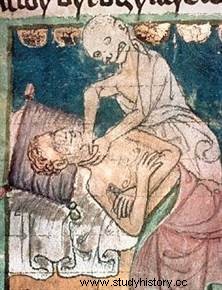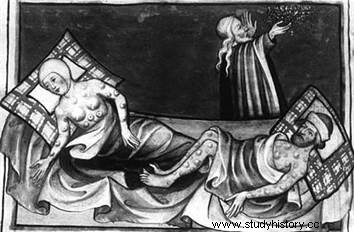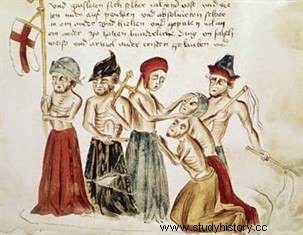 TheBlack Death , also called the Great Plague , is an epidemic that appeared in the Mediterranean basin in the middle of the 14th century, causing the disappearance of a third of the European population. Coming from Asia, it would have reached Europe via the Silk Roads and Genoese merchant ships from Crimea. Transmitted mainly by the rat flea, this highly contagious infectious disease caused death in four days. In France, this epidemic occurs in the dramatic context of the beginning of the Hundred Years War. The "Great Plague" profoundly marked the end of the Middle Ages, and its demographic repercussions were felt for three centuries in Europe.
TheBlack Death , also called the Great Plague , is an epidemic that appeared in the Mediterranean basin in the middle of the 14th century, causing the disappearance of a third of the European population. Coming from Asia, it would have reached Europe via the Silk Roads and Genoese merchant ships from Crimea. Transmitted mainly by the rat flea, this highly contagious infectious disease caused death in four days. In France, this epidemic occurs in the dramatic context of the beginning of the Hundred Years War. The "Great Plague" profoundly marked the end of the Middle Ages, and its demographic repercussions were felt for three centuries in Europe.
Previous plague outbreaks
Europe has already suffered two great waves of epidemics, in Antiquity and during the High Middle Ages (plague of Athens, between 430 and 427 BC). BC, and the plague of Constantinople, which began in 542 AD). Subsequently, the medieval West was the victim of epidemics on several occasions, in particular of leprosy, but, by its spread and its repetition, the Great Plague constituted a phenomenon of a magnitude unknown until then.
 At the end of the 14th century, after a long phase of demographic growth, the European population entered a phase of stagnation. As in previous epidemics, undernourishment, scarcity and famine provide fertile ground for the spread of the disease; overcrowding and poor living and hygienic conditions (particularly in urban areas) only aggravate the situation:bubonic plague (fatal in 80% of cases, transmitted to humans by the rat flea ) and pneumonic plague (deadly in almost all cases, contagious between humans) wreak enormous havoc.
At the end of the 14th century, after a long phase of demographic growth, the European population entered a phase of stagnation. As in previous epidemics, undernourishment, scarcity and famine provide fertile ground for the spread of the disease; overcrowding and poor living and hygienic conditions (particularly in urban areas) only aggravate the situation:bubonic plague (fatal in 80% of cases, transmitted to humans by the rat flea ) and pneumonic plague (deadly in almost all cases, contagious between humans) wreak enormous havoc.
The arrival of the Black Death in Europe
Part of Central Asia in the 1330s, the Great Plague or Black Death soon spread to China and India, following trade routes. It is possible that the leader of the Mongols, inventor of "biological warfare", catapulted the corpses of plague victims into Caffa, a Genoese port on the Black Sea besieged in 1347. Then, the Genoese ships landed in the ports of the western Mediterranean, in particularly in Marseilles, their cargo and their patients.
At the end of 1347, the disease reached Avignon, city of the Popes since 1309 and center of the Christian world. The following year, all of France, Spain, southern England, Italy, the Balkans and then, in 1349, the rest of Europe (with the exception of Bohemia, Hungary and large pockets in Poland, Béarn and Flanders) are affected.
Highly concentrated population groups, armies, monasteries and towns are particularly affected, while some city-states, such as Milan and Nuremberg, are miraculously spared. In addition, the plague affects the different categories of the population very unequally. The urban proletariat, already weakened by misery and scarcity, is paying a heavy price. The aristocracy and the bourgeoisie, which are better fed and have better sanitary conditions, are privileged in the face of this scourge. They also have the possibility of fleeing in the face of the progression of the epidemic. Less densely populated areas, especially the countryside, are also more spared.
A devastating pandemic
The form of the disease can be bubonic or pulmonary, or, as is the case in 1348-1349, be complicated by both forms. In the case of bubonic plague, contagion occurs through the black rat flea, the species of which invaded the West in the 10th century. The patient suffers from buboes in the armpit, groin and neck. His body is quickly covered with pustules, his limbs turn black. He has convulsions, vomits blood. Some about a third of them can survive But, in its pulmonary form, the germ, transmitted directly from man to man by inhalation, causes a lightning evolution which leads inexorably to death by asphyxiation within three days. Faced with such a scourge, contemporaries are powerless.
Prophylactic procedures are ridiculous and the only way to escape the disease is to flee promiscuity. Only the rich can afford it:they wall themselves in or take refuge in their houses in the countryside. It is also possible that the disease strikes more easily the young and those who are hungry and anemic. The plague therefore operates a kind of social selection, which, however, is attenuated by its repetition every ten to twelve years. Who can escape him for sure? it was not until 1720 that France experienced the last plague epidemic:the black rat retreated before the gray rat, while progressive immunization became part of the genetic heritage of men.
The Black Death, a divine curse?
The population of the time saw the epidemic as a manifestation of divine wrath. In the absence of a medical remedy, she is won over by a renewed Christian fervor. A vast movement of expiation and flagellants develops throughout Europe. Some communities serve as scapegoats, such as the Jews. Accused of poisoning, they suffered pogroms, notably in Spain and Germany (2,000 executions in Strasbourg, in February 1349).
 The Great Plague saw the emergence of many manifestations of flagellants, who belonged to a fanatical religious sect of Eastern Europe. XIIIth century. Convinced of the imminence of divine wrath, the flagellants do penance by beating each other collectively in public. Faced with the magnitude of the movement during the Black Death and following the sectarian outbursts it generated, Pope Clement VI declared the flagellants heretics in 1349. At the beginning of the 15th century, the sect was definitively condemned by the Council of Constance ( 1414-1418).
The Great Plague saw the emergence of many manifestations of flagellants, who belonged to a fanatical religious sect of Eastern Europe. XIIIth century. Convinced of the imminence of divine wrath, the flagellants do penance by beating each other collectively in public. Faced with the magnitude of the movement during the Black Death and following the sectarian outbursts it generated, Pope Clement VI declared the flagellants heretics in 1349. At the beginning of the 15th century, the sect was definitively condemned by the Council of Constance ( 1414-1418).
Europe devastated by the Great Plague
Nearly 25 million people are believed to have perished from the plague, with the proportion of deaths reaching almost half the population in some countries, such as France. In the long term, the epidemic significantly accelerated the demographic decline that began at the beginning of the century, mainly due to its recurrence (1360, 1369, 1375, etc.) and its impact on the youngest categories of the population. The disease remained endemic until the 18th century:the last major western manifestation of the Black Death dates from 1720-1722 and is still known as the “Peste de Marseille”.
From an economic point of view, the Great Plague brought medieval Europe into a period of recession, due to the shortage of labor, the decline in consumption and the return to fallow land of vast areas hitherto cultivated. These troubled times also had an influence in the artistic field:painting moved towards more gloomy themes, imbued with the supernatural...
Today, the plague still exists in Asia, Africa, South America and Australia, but rarely occurs in Europe. In the United States, the last major epidemic dates back to 1919. In 1950, the World Health Organization (WHO) launched health level control programs around the world in order to eradicate this disease once and for all.
To go further
- The Black Death and its ravages:Europe decimated in the 14th century, by Jonathan Duhoux. 50 minutes, 2015.
-France in the Middle Ages:From the Year 1000 to the Black Death , 1348, by Marie-Anne Polo de Beaulieu.
